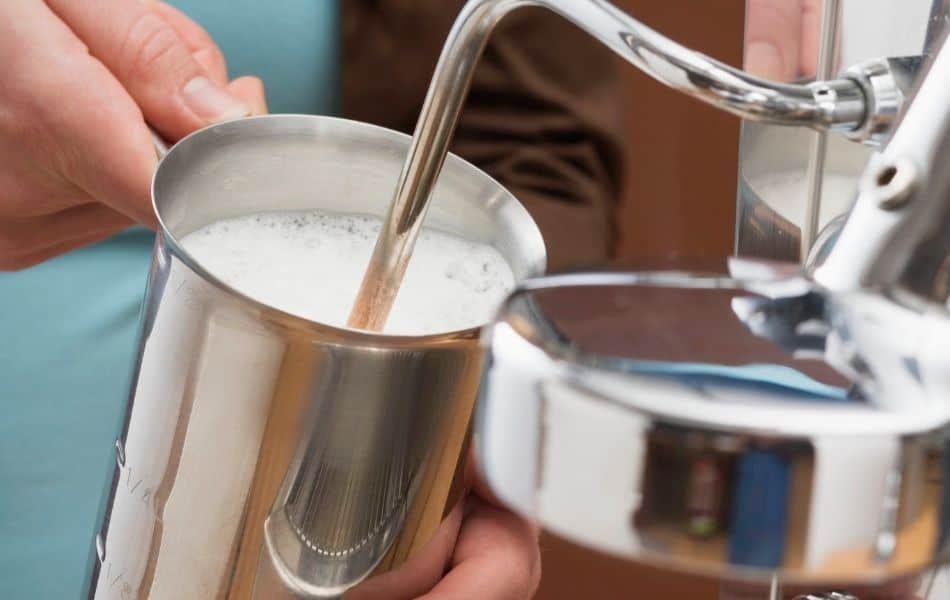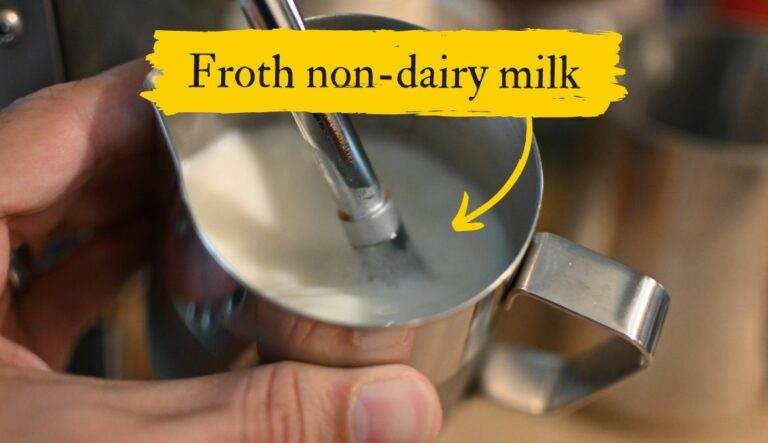
The key to a good latte or cappuccino is delightfully frothy milk. Sure, the coffee itself is essential, but without those all-important frothy bubbles, it is just a milky coffee. You may have noticed that whenever a barista knocks you up a tasty latte, they froth the milk separately before pouring it in with your coffee.
It doesn’t add that much time to the coffee-making process, but you might have found yourself wondering can you froth milk and coffee together? Frothing milk and coffee together reduces the texture of the frothing bubbles. It is not recommended. Adding coffee dilutes the protein content of your milk, which causes the bubbles to form inadequately. You also risk ruining the crema on your espresso shot.
Frothy coffees like lattes are an undeniably compelling combination of flavor and texture, but you don’t need to spend a small fortune on a commercial-grade frothing machine to make a great frothy coffee at home.
Why you should not froth coffee with milk
It’s up to you whether or not you want to experiment frothing your milk and coffee together. I have tried and wouldn’t recommend it for a few reasons.
Frothing together creates a poor milk consistency
High-protein milk froths best because the protein wraps around the froth bubbles and protects them from popping. So when you combine coffee and milk, especially low-protein milk, you dilute the protein content and reduce the liquid’s ability to retain froth bubbles.
Therefore, you’re better off frothing your milk separately to create a better forth consistency, and then adding it to your coffee after.
If you would like to froth your coffee and milk together, choose a milk with high protein content, such as any dairy milk or soy milk.
Frothing ruins your espresso crema
The crema is the top layer of micro-foam when you pull an espresso shot. Many coffee drinkers love the texture of the crema. Unfortunately, the crema texture will be ruined and lost when you froth it together with milk.
To maintain a delicious crema texture, I recommend slowly pouring your milk froth into your espresso shot, keeping the crema floating atop.
Ways to Froth Milk Without a Frothing Machine
Many of us have espresso machines in our homes, and even more of us have ways of making a nice shot of strong coffee with French presses and Moka pots. Making frothy milk to put in our coffees is not quite as straight forward, but it is definitely doable, and with far less in the way of specialist barista equipment than you might expect.
One common factor regardless of how you froth your milk is that you should heat it to around 150 degrees Fahrenheit. Failing to do this will cause your milk to lose much of the sweetness that it brings to the drink. On the other hand, if you heat it too much, the milk will taste off and won’t froth as well. It can also help to prepare your milk by giving the container you frothing it in a good solid tap to break up any large bubbles that might have formed, and then giving it a swirl.
Finally, it is important to remember that your milk-if adequately frothed-will increase in volume to somewhere around double what it was when you started. This is important not just for your measurements but also if you are frothing your milk in a relatively small container, you will need to make sure it is large enough to contain the frothed volume of the milk.
Now, with the general advice out of the way, let’s get into our top ways for frothing milk without using a milk frothing machine.
Froth milk by shaking vigorously in a container
We thought we’d start simple. All you need for this method is a container with a sealable lid. We’d recommend a glass jar since that will allow you to see the milk inside, so you don’t need to keep popping the lid off to see if your milk is frothy enough.
Once you’ve put your warm milk in the container, seal the lid, and give the container a vigorous shaking. Make sure you have a firm grasp on the container as you don’t want it to go flying off into the distance and almost certainly making a mess. You may also want to hold it with a dish towel if the container is thin because of the heat. Assuming your container is roughly cylindrical in shape, we would recommend holding it top and bottom. This should not only give you the best grip on the container but also prevent the lid from popping off.
Whisk your milk by hand
The next method you can try is whisking using a good old fashioned hand-powered whisk. While this is a little more difficult than the above jar-shaking method, a whisk tends to be more effective at producing better-quality foam.
It should hopefully go without saying that you need to be careful not to decorate your kitchen counter and walls with frothy milk. We would definitely recommend a high-sided bowl for this. The faster you can whisk (without injuring yourself), the better quality the foam will be, which brings us nicely to our next method of frothing your milk…
Use an electric whisker to froth your milk
It’s amazing how easy things can become when you add a little electricity, and that is certainly the case for whisking the milk. We are, of course, talking about using an electric whisker, not electrifying the milk.
An electric whisker will produce better froth than shaking it in a jar, of course, but unless you have a very poor whisker or remarkably fast hands, it should also produce much better foam than hand-whisking can. Again, you will want to make sure you are whisking in a bowl with high enough sides to make sure you don’t get milk everywhere.
Froth milk by using a standard kitchen blender
Yes. Yes, it will blend. In any kind of escalating mixing scenario, blending will invariably be the final stage, and milk frothing is no different. As a general rule, blending on a medium setting is the best way to go, being sure to check that your blender’s lid is firmly in place. If you are using a handheld blender, the process is much the same as an electric whisk, though it is arguably more difficult to keep the milk in the bowl.
Froth milk by using a frothing wand
This one might be cheating a little bit since we boasted methods that don’t require specialist barista equipment. While coffee isn’t the only thing you would own a frothing wand for, it is not a common kitchen utensil, so there’s a good chance you might end up buying one just for this.
The process is the same as using an electric whisker or immersion blender. As the name suggests, a frothing wand is a tool designed for creating froth, so expect better results than if you’d used a whisker or blender. But you’ll still want to be careful of the mess it can create!
Froth milk using a French Press
Granted, a French press could arguably be considered to be specialist barista equipment, but it is not for frothing things, and there is a greater chance your average coffee enthusiast is going to own one of these.

